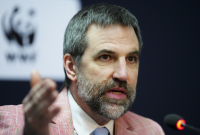Support strong Canadian climate journalism for 2025
Planet-warming greenhouse gas emissions linked to Canada’s fossil fuel industry continue to grow according to new data, with the oil and gas industry responsible for over a third of the country’s total emissions.
On Thursday, Environment and Climate Change Canada published its National Inventory Report — an annual detailed accounting of the country’s total greenhouse gas emissions — as required under the Paris Agreement. The report provides emissions data from 1990 to 2022, the most recent year available.
According to the report, Canada’s greenhouse gas emissions remain below pre-pandemic levels, and are, in fact, the lowest in 25 years, except for the pandemic years of 2020 and 2021 when sharp emissions reductions occurred as economies ground to a halt. For Environment and Climate Change Minister Steven Guilbeault, the results are encouraging and speak to a suite of government policies taking effect.
“We knew emissions were going to bounce back in 2022 as our economy burst back to life,” Guilbeault told reporters. “And we did see emissions increase between 2021 and 2022 in the transportation sector, the building and housing sector and some parts of the oil and gas, notably oilsands.
“But overall, this updated report shows significantly lower emissions by 44 million tonnes than our pre-pandemic levels. That is the equivalent of removing 13 million vehicles from our roads.”
In 2022, Canada’s emissions totalled 708 megatonnes (Mt) of planet-warming greenhouse gas emissions. That represents a 1.3 per cent increase from 2021 or a 5.9 per cent drop from 2019.
Specifically, sector greenhouse gas emissions in 2022 were:
- 217 Mt in oil and gas, up one Mt from the previous year.
- 156 Mt in transportation, up six Mt from the previous year.
- 89 Mt in buildings, up four Mt from the previous year.
- 78 Mt in heavy industry, which was the same as the previous year.
- 70 Mt in agriculture, up one Mt from the previous year.
- 51 Mt in waste and other sectors, up two Mt from the previous year.
- 47 Mt in the electricity sector, down four Mt from the previous year.
Any emissions reductions achieved were wiped out by increased emissions in the transportation, buildings, oil and gas, agriculture, and waste sectors.
Perhaps most importantly for those concerned with Canada’s growing fossil fuel emissions, since 2005, crude bitumen and synthetic crude oil production from the oilsands has grown 240 per cent, representing a 46 Mt increase over that period.
Catherine Abreu, founder of Destination Zero and a member of Canada’s Net-Zero Advisory Body, said the ongoing increase of emissions from the oil and gas sector reflects the absence of climate policy specifically designed to tackle those emissions.
“Climate policy works where it exists,” she told Canada’s National Observer. Abreu pointed to the output-based pricing system (the industry-facing carbon price) as an effective policy that is expected to drive significant reductions by 2030 when Canada has committed to cut 40 per cent of its emissions from 2005 levels.
According to the Canadian Climate Institute, the industrial carbon price is the workhorse of Canada’s emission reduction policies, forecasted to slash 23 to 39 per cent of the country’s total emissions by 2030. Comparatively, the consumer carbon price, called the fuel charge, is expected to be responsible for eight to nine per cent.
It’s important to have “both sides of the carbon pricing coin” in place, Abreu said. But specifically, the oil and gas sector needs an emissions cap sooner rather than later to complement the industrial carbon price.
If oil and gas sector emissions are allowed to continue rising, it means other sectors of the economy and other regions of the country have a heavier lift ahead of them to meet the country’s emission reduction targets, she said.
“We see that one part of the country is now contributing over a third of Canadian emissions, and that is a challenge,” she said. “But as we have to continue deepening the action we’re taking on climate change … it will be a bigger and bigger question of whether it’s fair and makes sense for us to be attributing this very rapidly shrinking carbon budget for Canada to one sector and one place alone.”
In December, the federal government unveiled its oil and gas emissions cap framework as part of its consultation process to design the policy. The framework proposes an upper legal limit for oil and gas emissions at 131 to 137 million tonnes in 2030. Of that target, oil and gas companies will be required to slash 106 to 112 million tonnes of greenhouse gas emissions from their operations, representing a 35 to 38 per cent decrease from 2019 levels.
At the time, Guilbeault said draft regulations for the emissions cap could be expected in the first half of 2024. But that timeline is being pushed back. Guilbeault said Thursday that draft regulations would be available in the fall. The rules won’t be phased in until at least 2026.
“This is a policy that's seen a lot of timeline slip,” Pembina Institute oil and gas program manager Janetta McKenzie told Canada’s National Observer. “It's a complex policy. It takes time to design. It takes time to implement, but I do think ultimately, this policy needs to move as quickly as possible if we want to see emissions from the oil and gas sector really begin to meaningfully come down by 2030.”
McKenzie said the federal government is offering carrots in the form of investment tax credits for companies to decarbonize, but it’s time to use the emissions-cap stick, too.
Oil and gas companies need certainty to make major investments, she said, and “we know they won't do it without a regulation because we haven't seen those investments come to light yet.”
Guilbeault appears to agree.
“We're putting our money where our mouth is, and I would like to see industry do the same,” he said. “There's billions of dollars of federal money to help these companies invest in carbon capture and storage.”
Referring to the Pathways Alliance, composed of Canada’s six-largest oilsands companies (Suncor, Imperial Oil, Canadian Natural Resources, MEG Energy, Cenovus, and ConocoPhillips), which has pitched the government on a massive $16.5-billion carbon capture project, Guilbeault said they’ve been talking about it for two years and still have no sign of the companies’ investment plan.
“I think we've made good on our promise,” he said. “There's lots of money on the table for them. They need to put some of their own money [in] as well.”
As previously reported by Canada’s National Observer, the oil and gas industry lobbied aggressively last year as the emissions cap framework was being developed, racking up over 1,000 meetings with government officials.
Revelations about the increase in oil and gas emissions come a day after the $34-billion Trans Mountain oil pipeline expansion project officially opened. The pipeline increases capacity from 300,000 barrels per day to 890,000 barrels per day. Because increased capacity facilitates increased production, climate advocates are concerned emissions from the sector will keep growing.
Oil production in Alberta hit record highs in February, with Crown corporation ATB Financial chalking it up to anticipation of Trans Mountain opening for business.






Comments
The federal government needs to up the ante on Chapter 2, implementing durect emisdion control regulations. They have given industry enormous skack and largesse in Chapter 1 subsidies and hundreds of pne-on-one negotiating sessions behind closed doors.
Chapter 3 would entaul dit
.....would entail direct equity investment and partnerships in renewable power projects, national scale HVDC transmission corridors, urban transit, intercity commuter rail and national level EV charging projects under direct federal jurisdiction and ownership, deep renovation of federal policy and involvement in agriculture to foster regenerative practices (conservation tillage, cover cropping...), and so forth.
Chapter 3 would be the most effective way to ensure the transition is never stalled and benefits all.
"The framework proposes an upper legal limit for oil and gas emissions at 131 to 137 million tonnes in 2030. Of that target, oil and gas companies will be required to slash 106 to 112 million tonnes of greenhouse gas emissions from their operations, representing a 35 to 38 per cent decrease from 2019 levels."
Really. And who's gonna make them???
"Guilbeault said Thursday that draft regulations would be available in the fall. The rules won’t be phased in until at least 2026."
In other words, they'll once again blame inaction on the Conservatives, who'll cancel anything that oil and gas doesn't like.
In addition to AlexB's comments, I'd mention:
"https://electrical-engineering-portal.com/8-main-disadvantages-of-hvdc-…
And, frankly, I'm sick unto death of private concerns taking over national goods and infrastructure, pumping $$$ to themselves and FWICT, paying little to Canadian government coffers outside of bribing candidates and officials.
I'd suggest a more efficient way would be to tax them on their excess profits, and use those monies to fund national power generation and transmission infrastructure.
At some point (seemingly not sooner, but later) when no one, even with 0/20 vision, can still be blind to the reality that government has been had ... and by the balls to boot.